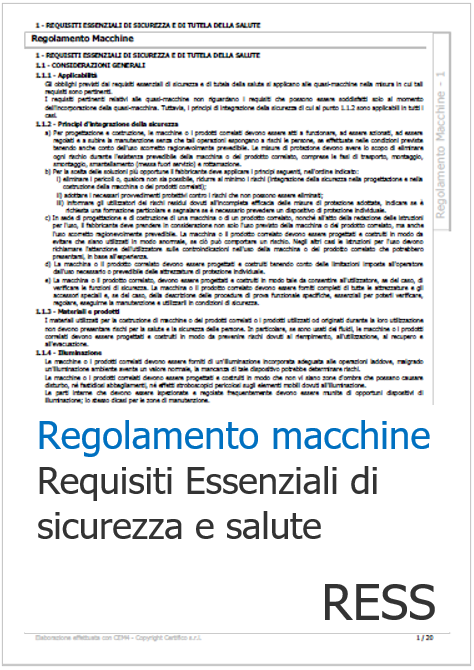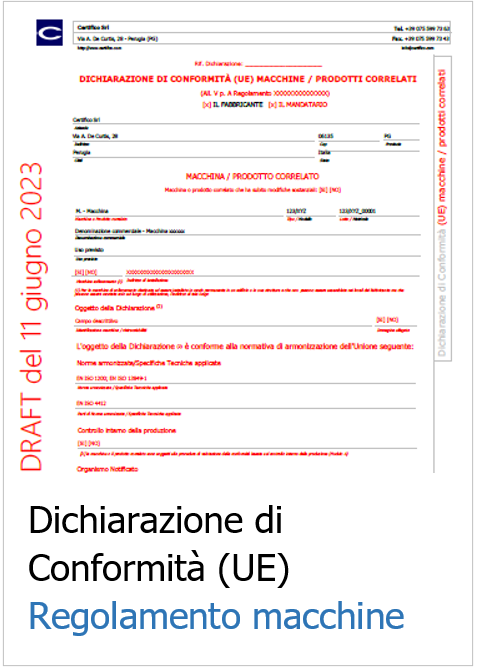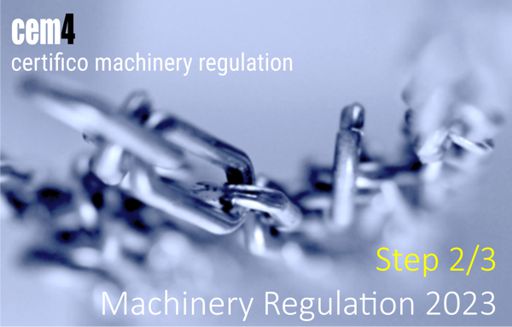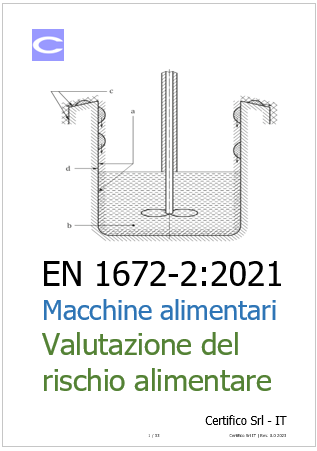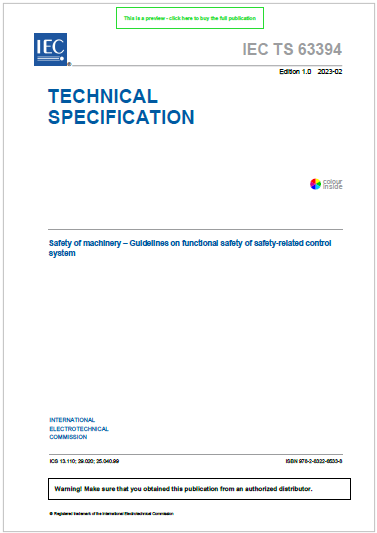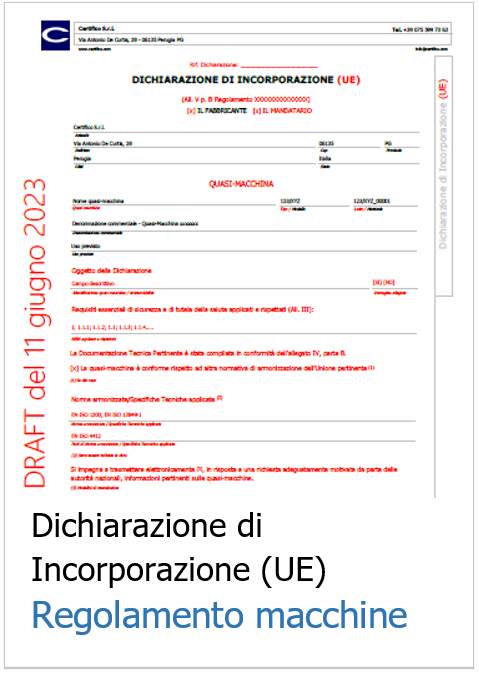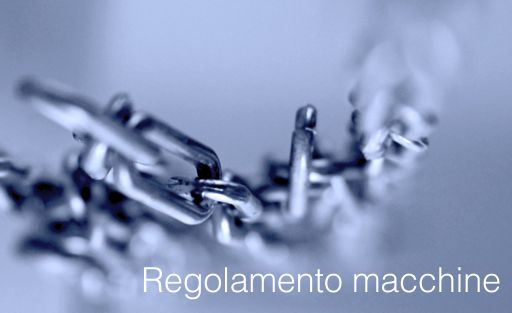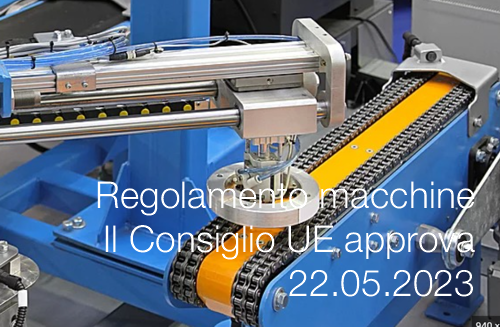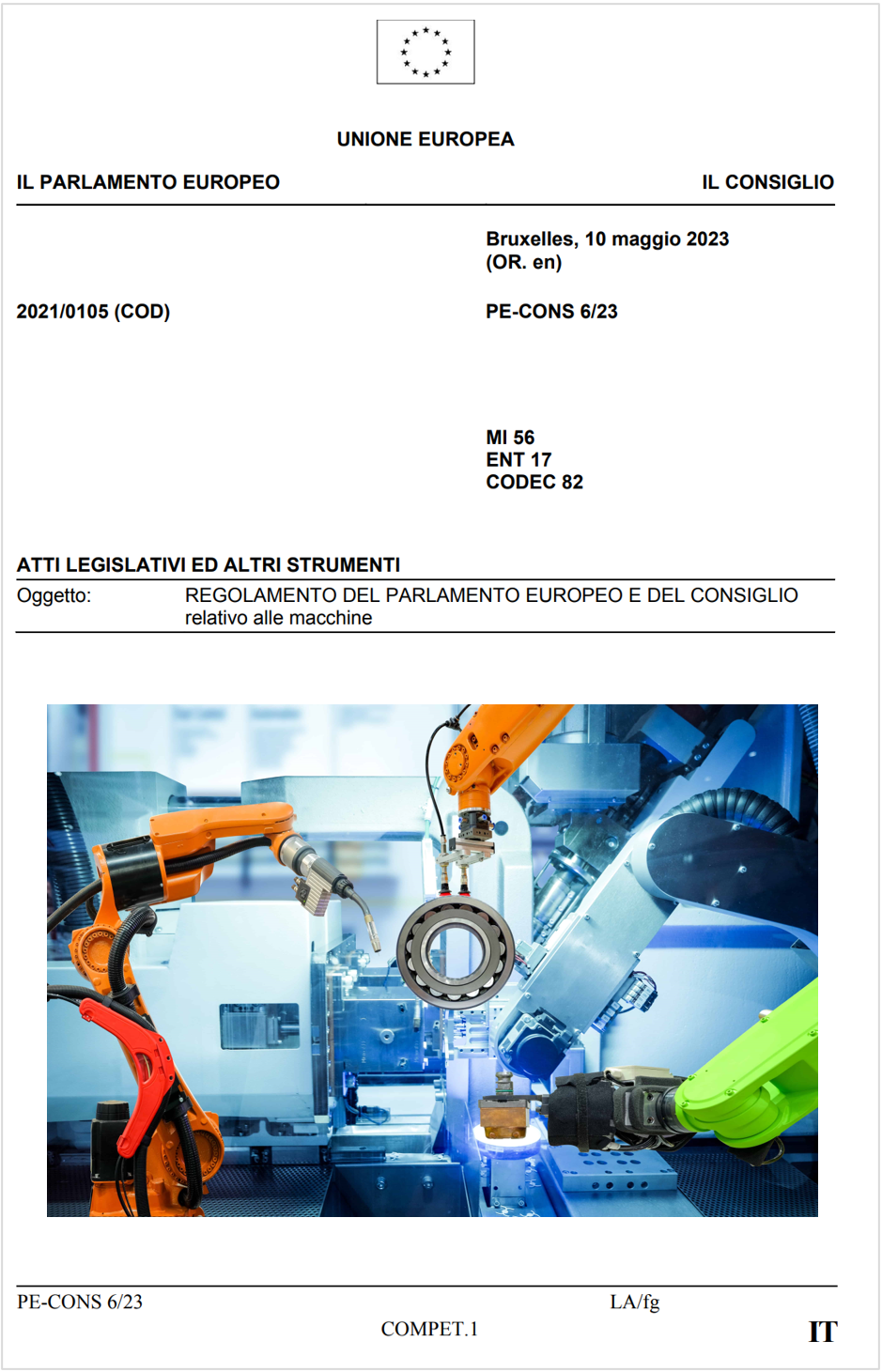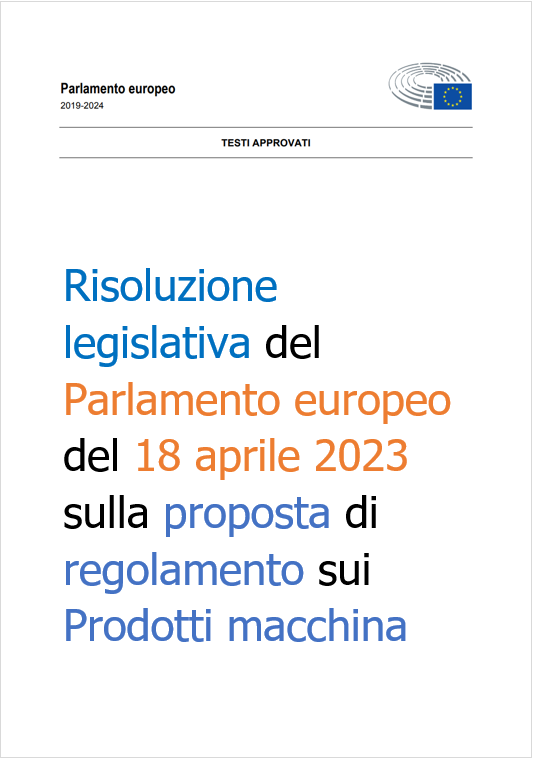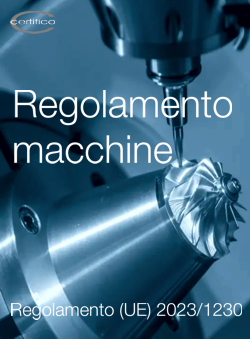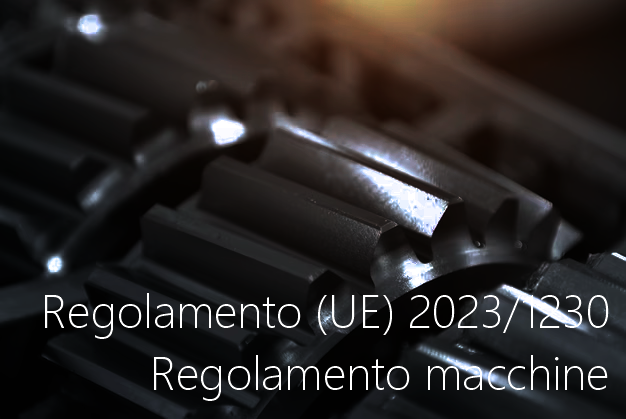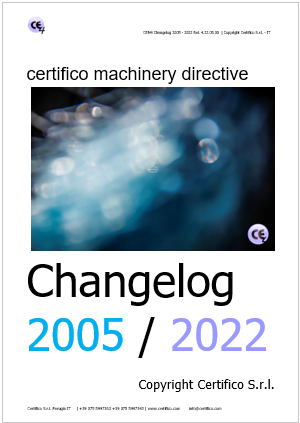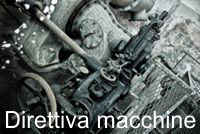Regolamento macchine: i Requisiti Essenziali di sicurezza e salute RESS
Regolamento macchine: i Requisiti Essenziali di sicurezza e salute RESS / Estratto template CEM4 - Draft 14.06.2023
Proponiamo Draft 14.06.2023 dell'elenco dei RESS (Allegato III) di cui al Regolamento macchine 2023 elaborato template CEM4, su testo Regolamento macchine approvato definitivamente dal Consiglio PE-CONS 6-23 in data 23.05.2023 - non in GU.
DRAFT 14.06.2023 / non definitivo, si attende pubblicazione Regolamento in GU - Template Certifico / CEM4
ALLEGATO III Requisiti essenziali di sicurezza e di tutela della salute relativi alla progettazione e alla costruzione di macchine o prodotti correlati
Parte A DEFINIZIONI
Ai fini del presente allegato si intende per:
a) "pericolo": una potenziale fonte di lesione o danno alla salute;
b) "zona pericolosa": qualsiasi zona all'interno e/o in prossimità di una macchina o di un prodotto correlato in cui la presenza di una persona costituisca un rischio per la sicurezza o la salute di detta persona;
c) "persona esposta": qualsiasi persona che si trovi interamente o in parte in una zona pericolosa;
d) "operatore": la persona o le persone incaricate di installare, di far funzionare, di regolare, di pulire, di riparare e di spostare una macchina o un prodotto correlato o di eseguirne la manutenzione;
e) "rischio", combinazione della probabilità e della gravità di una lesione o di un danno per la salute che possano insorgere in una situazione pericolosa;
f) "riparo": elemento di una macchina o di un prodotto correlato utilizzato specificamente per garantire la protezione tramite una barriera materiale;
g) "dispositivo di protezione": dispositivo (diverso da un riparo) che riduce il rischio, da solo o associato ad un riparo;
h) "uso previsto": l'uso di una macchina o di un prodotto correlato conformemente alle informazioni fornite nelle istruzioni per l'uso;
i) "uso scorretto ragionevolmente prevedibile": l'uso di una macchina o di un prodotto correlato in un modo diverso da quello indicato nelle istruzioni per l'uso, ma che può derivare dal comportamento umano facilmente prevedibile.
Parte B PRINCIPI GENERALI
1. Il fabbricante di una macchina o di un prodotto correlato deve provvedere affinché sia effettuata una valutazione del rischio per stabilire i requisiti essenziali di sicurezza e di tutela della salute che concernono la macchina o il prodotto correlato. La macchina o il prodotto correlato devono inoltre essere progettati e costruiti per eliminare i rischi o, ove non sia possibile, ridurre al minimo tutti i rischi pertinenti, tenendo conto dei risultati della valutazione del rischio.
Con il processo iterativo della valutazione del rischio e della riduzione del rischio di cui al primo comma, il fabbricante:
a) stabilisce i limiti della macchina o del prodotto correlato, il che comprende l'uso previsto e l'uso scorretto ragionevolmente prevedibile;
b) individua i pericoli cui può dare origine la macchina o il prodotto correlato e le situazioni pericolose che ne derivano;
c) stima i rischi, tenendo conto della gravità dell'eventuale lesione o danno alla salute e della probabilità che si verifichi;
d) valuta i rischi al fine di stabilire se sia richiesta una riduzione del rischio conformemente all'obiettivo del presente regolamento;
e) elimina i pericoli o riduce i rischi che ne derivano, applicando le misure di protezione nell'ordine indicato nel punto 1.1.2, lettera b).
La valutazione del rischio e la riduzione del rischio includono i pericoli che possono manifestarsi durante il ciclo di vita della macchina o del prodotto correlato prevedibili al momento dell'immissione della macchina o del prodotto correlato sul mercato come un'evoluzione prevista del suo comportamento o della sua logica integralmente o parzialmente autoevolutivi in ragione del fatto che tale macchina o prodotto correlato è progettato per funzionare con livelli variabili di autonomia. La valutazione del rischio e la riduzione del rischio comprendono i rischi derivanti dalle interazioni tra macchine che per raggiungere uno stesso risultato sono disposte e comandate in modo da avere un funzionamento solidale, formando così una macchina come definita all'articolo 3, punto 1, lettera d).
2. Gli obblighi previsti dai requisiti essenziali di sicurezza e di tutela della salute si applicano soltanto se esiste il pericolo corrispondente per la macchina o il prodotto correlato in questione, allorché viene utilizzato nelle condizioni previste dal fabbricante o in condizioni anormali prevedibili.
Tuttavia, il principio di integrazione della sicurezza di cui al punto 1.1.2 e gli obblighi relativi alla marcatura delle macchine o dei prodotti correlati di cui al punto 1.7.3 e alle istruzioni per l’uso di cui al punto 1.7.4 si applicano in ogni caso.
3. I requisiti essenziali di sicurezza e di tutela della salute elencati nel presente allegato sono inderogabili; tuttavia, tenuto conto dello stato dell’arte, gli obiettivi da essi prefissi possono non essere raggiunti. In tal caso, la macchina o il prodotto correlato, per quanto possibile, deve essere progettato e costruito per tendere verso tali obiettivi.
4. Il presente allegato si articola in sei capi. Il primo capo ha una portata generale e si applica a tutte le macchine o prodotti correlati. Gli altri capi si riferiscono a taluni tipi di pericoli più specifici.
Tuttavia, è indispensabile esaminare il presente allegato in tutte le sue parti, al fine di essere certi di soddisfare tutti i pertinenti requisiti essenziali di sicurezza e di tutela della salute.
Nel progettare la macchina o un prodotto correlato si tiene conto dei requisiti contenuti nel primo capo e di quelli elencati in uno o più degli altri capi, in funzione dei risultati della valutazione del rischio condotta in conformità del punto 1 dei presenti principi generali.
I requisiti essenziali di sicurezza e di tutela della salute per la tutela dell'ambiente sono applicabili unicamente alle macchine o ai prodotti correlati a di cui al punto 2.4.
5. I presenti principi generali si applicano alla valutazione del rischio effettuata dal fabbricante di quasi-macchine.
1. REQUISITI ESSENZIALI DI SICUREZZA E DI TUTELA DELLA SALUTE
2. REQUISITI ESSENZIALI SUPPLEMENTARI DI SICUREZZA E DI TUTELA DELLA SALUTE PER TALUNE CATEGORIE DI MACCHINE E DI PRODOTTI CORRELATI
2.1. MACCHINE E PRODOTTI CORRELATI ALIMENTARI E MACCHINE E PRODOTTI CORRELATI PER PRODOTTI COSMETICI O FARMACEUTICI
2.2. MACCHINE O PRODOTTI CORRELATI PORTATILI TENUTI O CONDOTTI A MANO
2.3. MACCHINE O PRODOTTI CORRELATI PER LA LAVORAZIONE DEL LEGNO E DI MATERIE CON CARATTERISTICHE FISICHE SIMILI
2.4. MACCHINE O PRODOTTI CORRELATI PER L'APPLICAZIONE DI PRODOTTI FITOSANITARI
3. REQUISITI ESSENZIALI SUPPLEMENTARI DI SICUREZZA E DI TUTELA DELLA SALUTE PER OVVIARE AI RISCHI DOVUTI ALLA MOBILITÀ DELLE MACCHINE O DEI PRODOTTI CORRELATI
4. REQUISITI ESSENZIALI SUPPLEMENTARI DI SICUREZZA E DI TUTELA DELLA SALUTE PER PREVENIRE I RISCHI DOVUTI AD OPERAZIONI DI SOLLEVAMENTO
5. REQUISITI ESSENZIALI SUPPLEMENTARI DI SICUREZZA E DI TUTELA DELLA SALUTE PER LE MACCHINE O I PRODOTTI CORRELATI DESTINATI AD ESSERE UTILIZZATI NEI LAVORI SOTTERRANEI
6. REQUISITI ESSENZIALI SUPPLEMENTARI DI SICUREZZA E DI TUTELA DELLA SALUTE PER LE MACCHINE O I PRODOTTI CORRELATI CHE PRESENTANO RISCHI PARTICOLARI DOVUTI AL SOLLEVAMENTO DI PERSONE
(49) I requisiti essenziali di sicurezza e di tutela della salute dovrebbero essere soddisfatti al fine di garantire che il prodotto rientrante nell'ambito di applicazione del presente regolamento sia sicuro. Tali requisiti dovrebbero essere applicati con discernimento, tenendo conto dello stato dell'arte al momento della costruzione e delle esigenze tecniche ed economiche.
Articolo 3 Definizioni
14) "requisiti essenziali di sicurezza e di tutela della salute": le disposizioni obbligatorie, di cui all'allegato III, relative alla progettazione e alla costruzione di prodotti rientranti nell'ambito di applicazione del presente regolamento, intese ad assicurare un livello elevato di tutela della salute e di sicurezza delle persone e, ove opportuno, degli animali domestici nonché di tutela dei beni e, se del caso, dell'ambiente.
Vedi Documento
- Pubblicato: 14 Giugno 2023
- Visite: 6030





